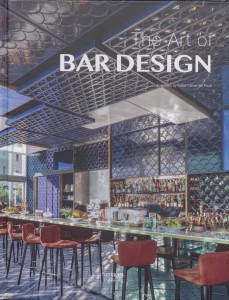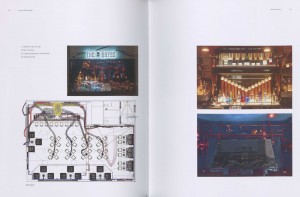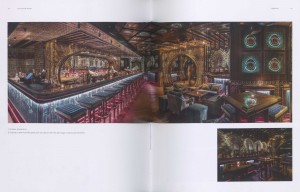 In this week’s batch of new recruits to the collection is this gem of a book, The Art of Bar Design, featuring a forward by Natali Canas del Pozo and stunning photographs of each of the highlighted bars. The book identifies four types of bars and the distinct styles within each category: cocktail bars, restaurant bars, nightclubs, and breweries and wine bars.
In this week’s batch of new recruits to the collection is this gem of a book, The Art of Bar Design, featuring a forward by Natali Canas del Pozo and stunning photographs of each of the highlighted bars. The book identifies four types of bars and the distinct styles within each category: cocktail bars, restaurant bars, nightclubs, and breweries and wine bars.
In the forward, Canas del Pozo writes about how “bars have historically been (even more so than  churches) the main interior spaces for people to gather and meet,” and bars must be physically inviting and be comfortable to people who are there for a variety of reasons (pg. 004). The bars discussed in the book are located all over the world, from Hong Kong to Munich to Seattle. There is a brief analysis written about each bar, but mostly Canas del Pozo lets the pictures have the final word.
churches) the main interior spaces for people to gather and meet,” and bars must be physically inviting and be comfortable to people who are there for a variety of reasons (pg. 004). The bars discussed in the book are located all over the world, from Hong Kong to Munich to Seattle. There is a brief analysis written about each bar, but mostly Canas del Pozo lets the pictures have the final word.
Starting with cocktail bars, comfort and a sense of intimacy seem to be crucial to a good bar design. It’s comfortable, where people can sit for hours during an evening out, but the finishes are also key. The location is also key in designing some of those finishes, as in the case of the Blue Wave Cocktail Bar in Barcelona, which sits on the edge of the water in Barcelona’s port, and the backsplash behind the bar appropriately mimics seashells. Similarly, restaurant bars are  designed to have a welcoming warmth to them that blends in with the rest of the restaurant. Everything here goes along with the meal experience, rather than the bar being the center of everything as in cocktail bars and nightclubs. Some of the most opulent bars are at nightclubs. where the bar is frequently a statement piece that occupies much of a room. One example in particular stands out: Ophelia in Hong Kong, where the decor features peacock feathers. The nightclub as a whole is a spectacle and the photographs are stunning. Finally, breweries and wine bars are places where the alcohol itself is highlighted. The atmosphere is frequently laid back and epitomizes the culture of the brewery or winery. Patrons are there purely to enjoy and sample the drinks, rather than socialize in the same way as at a nightclub. And the bars at breweries and wine bars reflect that through their focus on the process of brewing and making wine (e.g. through display of wine barrels and the ability to see the brewery from the tap room).
designed to have a welcoming warmth to them that blends in with the rest of the restaurant. Everything here goes along with the meal experience, rather than the bar being the center of everything as in cocktail bars and nightclubs. Some of the most opulent bars are at nightclubs. where the bar is frequently a statement piece that occupies much of a room. One example in particular stands out: Ophelia in Hong Kong, where the decor features peacock feathers. The nightclub as a whole is a spectacle and the photographs are stunning. Finally, breweries and wine bars are places where the alcohol itself is highlighted. The atmosphere is frequently laid back and epitomizes the culture of the brewery or winery. Patrons are there purely to enjoy and sample the drinks, rather than socialize in the same way as at a nightclub. And the bars at breweries and wine bars reflect that through their focus on the process of brewing and making wine (e.g. through display of wine barrels and the ability to see the brewery from the tap room).
This is a really interesting look at spaces that people often do not consider when out at restaurants and bars. Depending on the purpose of the space, the location and size of the bar varies. The bar is the heart of a nightclub and a cocktail bar, where people often go to socialize, whether with friends or to meet new people, and the bar must be reflective of that. While at a restaurant or a brewery, the bar itself is an important part of the eating and drinking experience, but one that is not at the heart of the experience. All the same, the design of the bar says a lot about the business, its culture, its audience, its taste, and what people do while there. So next time you go out, whether to a club or a bar or a restaurant, notice how the bar is designed. How well does it fit with the rest of the business? Where is it located within the space, is it at the center of all with comfortable stools, or is it an aside where there is only space to stand? What are the finishes like? What kind of statement does it make about the space and the people who work and frequent there? You’ll probably never look at a bar quite the same way again.
